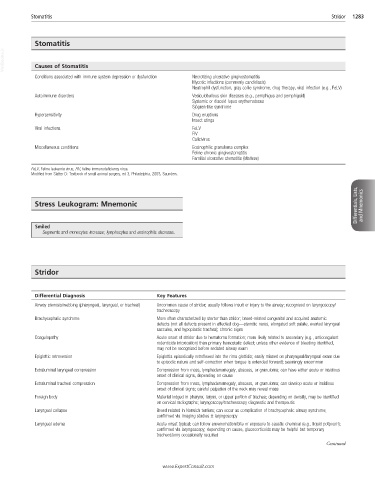Page 2550 - Cote clinical veterinary advisor dogs and cats 4th
P. 2550
Stomatitis Stridor 1283
Stomatitis
VetBooks.ir Causes of Stomatitis
Conditions associated with immune system depression or dysfunction Necrotizing ulcerative gingivostomatitis
Mycotic infections (commonly candidiasis)
Neutrophil dysfunction, gray collie syndrome, drug therapy, viral infection (e.g., FeLV)
Autoimmune disorders Vesiculobullous skin diseases (e.g., pemphigus and pemphigoid)
Systemic or discoid lupus erythematosus
Sjögren-like syndrome
Hypersensitivity Drug eruptions
Insect stings
Viral infections FeLV
FIV
Calicivirus
Miscellaneous conditions Eosinophilic granuloma complex
Feline chronic gingivostomatitis
Familial ulcerative stomatitis (Maltese)
FeLV, Feline leukemia virus; FIV, feline immunodeficiency virus.
Modified from Slatter D: Textbook of small animal surgery, ed 3, Philadelphia, 2003, Saunders.
Differentials, Lists, and Mnemonics
Stress Leukogram: Mnemonic
Smiled
Segments and monocytes increase; lymphocytes and eosinophils decrease.
Stridor
Differential Diagnosis Key Features
Airway stenosis/webbing (pharyngeal, laryngeal, or tracheal) Uncommon cause of stridor; usually follows insult or injury to the airway; recognized on laryngoscopy/
tracheoscopy
Brachycephalic syndrome More often characterized by stertor than stridor; breed-related congenital and acquired anatomic
defects (not all defects present in affected dog—stenotic nares, elongated soft palate, everted laryngeal
saccules, and hypoplastic trachea); chronic signs
Coagulopathy Acute onset of stridor due to hematoma formation; more likely related to secondary (e.g., anticoagulant
rodenticide intoxication) than primary hemostatic defect; unless other evidence of bleeding identified,
may not be recognized before sedated airway exam
Epiglottic retroversion Epiglottis episodically retroflexed into the rima glottidis; easily missed on pharyngeal/laryngeal exam due
to episodic nature and self-correction when tongue is extended forward; seemingly uncommon
Extraluminal laryngeal compression Compression from mass, lymphadenomegaly, abscess, or granuloma; can have either acute or insidious
onset of clinical signs, depending on cause
Extraluminal tracheal compression Compression from mass, lymphadenomegaly, abscess, or granuloma; can develop acute or insidious
onset of clinical signs; careful palpation of the neck may reveal mass
Foreign body Material lodged in pharynx, larynx, or upper portion of trachea; depending on density, may be identified
on cervical radiographs; laryngoscopy/tracheoscopy diagnostic and therapeutic
Laryngeal collapse Breed related in Norwich terriers; can occur as complication of brachycephalic airway syndrome;
confirmed via imaging studies ± laryngoscopy
Laryngeal edema Acute onset typical; can follow envenomation/bite or exposure to caustic chemical (e.g., liquid potpourri);
confirmed via laryngoscopy; depending on cause, glucocorticoids may be helpful but temporary
tracheostomy occasionally required
Continued
www.ExpertConsult.com

